Thirty years later the first glass-maker appears on the roll of the city’s freemen. But seven years previously1 we read that a certain townsman was admitted a freeman of the city upon his undertaking2 to train a city schoolboy, as his apprentice3, in the difficult art of glass “grinding” without the usual premium4 of £7. But as early as 1666 an order was made by the City Council to the effect that “no stranger or foreigner should presume to open a shop, either with or without glass windows, under a penalty of £5”—a fact which seems to indicate that, although{116} glass windows may still have been a novelty, there existed facilities for their supply if required.
Apart from casual references like these, the history of Bristol glass is entirely5 obscure. But as the trade returns for the year 1695 show that the duty on glass for that year amounted to £17,642, and that a “drawback” allowed on exported glass amounted in the case of Bristol to no less a sum than £2976, it is pretty clear that by that time the industry in Bristol had assumed very considerable dimensions.
Bristol glass is certainly the most beautiful of all Old English glass, and there is no doubt that many of the fine specimens6 one sees, both coloured and plain, were actually produced in the factories of that city. The colouring of Bristol glass is exceptionally brilliant, especially its deep blues8. The opaque9 milky10-white ware11, which is most common, is often “ribbed” with white streaks12 or ornamented13 with flowers in colours and gold, or daubed with red, blue, and yellow, or with one of these colours only. Fig14. 29 shows specimens of both kinds.
It is a matter for great regret that the factories renowned15 in early times for the beauty and{117} finish of their output did not maintain their existence for a longer period. The exact date at which the famous opaque ware was made is open to considerable doubt, but the year 1760 cannot be very wide of the mark, for reasons to which I have already referred.
In any case, the records of the city show that in that year its glass furnaces were in full blast. We find recorded in 1715 a bequest16 of china and glass, and in a long account of a feast given to commemorate17 the accession of Queen Anne there is included among the expenditure18 of the corporation an item of £6, 14s. for glasses.
At first glass was extremely costly19: the corporation was called upon to pay no less than £4, 16s. for “a glass to be placed in Mr Alderman Laroche’s coach, which was broken at the gaol20 delivery.” Fine specimens of the glass-worker’s art fetched extremely high prices.
The glass itself was exceedingly brittle21 and easily broken as compared with other English and Irish glass. It was frequently decorated with enamelled colouring, and many specimens are found with finely curved and twisted handles. It was, in my opinion, the object of the Bristol glass-houses to imitate white porcelain23, and,{118} in support of this idea, we find manufactured in Bristol glass such articles as vases, cups and saucers, plates, mugs, and other utensils24 usually made from porcelain and earthenware25.
Of course, the art of manufacturing this opaque white or milky glass was well known abroad. The white glass of Venice, of Orleans, and of Barcelona was already famous. The characteristic feature of its manufacture was the large amount of lead and the small quantity of tin employed as ingredients—quantities altogether out of proportion to those used in the manufacture of ordinary transparent26 glass.
It is no very difficult task for an enthusiast27 to find to-day excellent specimens of Bristol ware. Its characteristic features are an extraordinary fineness in colour and texture28, coupled with a delicate taste both in hue29 and form. The ware, too, has a peculiar30 softness to the touch which is quite characteristic, and provides the amateur collector, once he has recognised it, with an excellent test as to the genuineness of the specimen7 under consideration. The smaller pieces are often beautifully decorated with painted or enamelled flowers, maidenhair fern, and the like.{119}
The illustrations (Figs. 25-26) give an excellent idea of the kind of decoration adopted by the master craftsmen31 of Bristol. The designs found upon Bristol glass were also, now and again, copies of those found on Venetian and French pieces. But, generally speaking, the decoration of Bristol glass was entirely English in conception and execution. This is particularly the case where the pieces were made for some special occasion or purpose, as, for example, the commemoration of some event of national importance.
Many examples from the Bristol factories are to be found in the various museums, especially at South Kensington, where in the famous Schrieber Collection are some of the finest examples extant. There is, for example, a “Venetian glass”—purely Bristol, of course, but on a Venetian model, which is reproduced as a frontispiece to this volume—and also a pair of candlesticks beautifully ornamented with butterflies, wild flowers, and leaves. They stand out as most admirable specimens from the Bristol factories.
It is a well-known fact that the Bristol product, so admirable was it in quality and appearance{120} and so closely did it resemble the real Venetian glass, was often passed off as the product of the Venice glass-makers—the pastmasters of the art. Many a collection, ostensibly hailing from Venice, must, on a closer scrutiny32, be attributed to a place of origin much nearer home. This form of substitution was particularly prevalent in the case of glass ornamented with white twisted threads and in the case of ruby-coloured glasses and mugs.
Many of the earliest specimens were left “raw” at the base, and if the finger be drawn33 across the ends the existence of sharp edges will become apparent. This is a test of reasonably good value, as I have found on more than one occasion when I have been in doubt. Also, and with the smaller pieces in particular, it was almost universal with the Bristol manufacturer to leave untouched the “mark” or place where the piece was nipped from the blower’s tube. Modern reproductions, whilst faithfully observing and imitating all the beauties of the model, have generally their bases perfectly34 smooth. Even where the “mark” has been imitated to give an added air of verisimilitude to the specimen, the thing has been overdone35, and that so
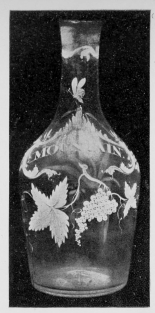
A BRISTOL GLASS DECANTER DECORATED WITH OPAQUE WHITE ENAMEL22. THE WORD “MOUNTAIN” BEING THE NAME OF A KIND OF SPANISH WINE USED IN THIS COUNTRY, CIRC. 1760.
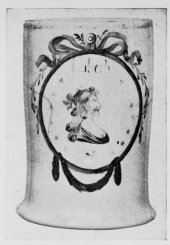
EARLY SPECIMEN OF BRISTOL GLASS MUG, WITH THE WORD “LIBERTY.”
FIG. 25.
awkwardly as inevitably36 to lead to detection. Sometimes, too, in the imitation, the colours used to produce the milky-white tone cease abruptly37, leaving the “mark” perfectly transparent. In genuine old Bristol the colour fades gradually, leaving only the very tip of the “mark” clear.
Another good test is to place the specimen in a strong light, preferably sunlight. If, when examined, the colour is mixed, the piece is of doubtful authenticity38. Spurious specimens often run “cloudy” or patchy, possibly because of bad mixing. This is, of course, a useful test, provided one does not rely upon it entirely, for certain specimens of undoubted authenticity display somewhat similar features. In particular, I remember an old drinking flask39 marked with irregular streaks of white, where this test would have proved absolutely misleading. Possibly the “feel” of the glass is the best criterion, genuine old Bristol being much softer to the touch than any modern imitation.
So many pitfalls40 await the average collector of Bristol glass that I should hardly advise anyone to make this his sole hobby, for although it is still possible to find small pieces—cups,{122} salt-cellars, small bowls, finger basins, mugs, and the like—the really important pieces of Bristol glass are few, and they and their owners are pretty well known to the cognoscenti. At any rate I have not met anyone, in recent years, who could boast of a considerable find in this direction.
A very fine specimen, described as “Old Bristol, 1760,” was put up for sale some eighteen months ago, near London. Its genuineness was further guaranteed by a label pasted on the base, showing that it had passed through a well-known London auction-room. The owner, a dealer41 in a small way, failing to find a customer in London, had put it into the sale of the effects of a cottage. It was bought in by its owner for £3, 3s., and eventually at the end of the day realised only 36s. I saw the piece subsequently. It was obviously a reproduction, though a very good one, and certainly worth what was given for it; but as he had purchased it as real old glass, and at a proportionate figure, it will, I fancy, be a long time before he again endeavours to secure a bargain in Old Bristol. I have known many such instances, and as a result of my experience I have come{123}
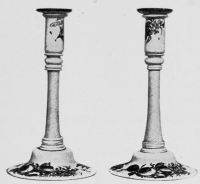
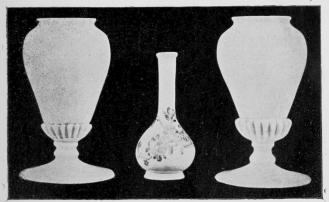
FIG. 26.—SPECIMENS OF BRISTOL GLASS.
(Enamel Colouring by Michael Edkin.)
to the conclusion that, while pieces of Bristol can be picked up now and again, particularly in the west of England, it will not pay the amateur collector to confine himself to this particular variety.
I am indebted to Mr Cole of South Molton Street, London, for the illustration (Fig. 26) of a pair of very fine early Bristol vases which, although undecorated, are exquisite42 in colour and form, and a beautiful example of the maker’s art. The frilling round the base deserves special notice.
The central piece in the photograph is a long-necked vase decorated with coloured enamels43, and known to be the work of Michael Edkin, a Bristol enameller44 of distinction. If carefully examined, it affords ample evidence of the skill and painstaking45 care to which the best specimens of this ware owe their artistic46 merit.
Spiral wine glasses are still often to be found in or near Bristol, and the fact that these are rarely found in other parts of the country seems to indicate that they were a favourite form with the Bristol glass-makers. Among the examples of Bristol ware here reproduced (Fig. 27) is included a pair of vases. These{124} rank among the finest specimens still extant of Michael Edkin’s work. This talented artist was a painter of some merit, who gradually drifted into glass painting, and for some twenty-six years, from 1762 to 1788, was engaged by various firms to decorate their ware with birds, flowers, etc. He was also, it may be added, a singer and an actor of no little distinction.
Fig. 26 shows a pair of candlesticks, 6? inches in height, from the British Museum Collection. They are excellent examples of Edkin’s taste and delicacy47 of execution. Great quantities of glass decorated by him must have been exported, and I have found undoubted specimens of his work in Rome and the museums of other Continental48 cities I have visited. One of the very finest specimens of his art is a richly gilt49 and decorated tea-tray, now in the Museum of Practical Geology. Another example from the British Museum Collection is the fine mug, ornamented with a portrait and the word “Liberty” in gold, possibly made by some sympathiser with the revolutionary spirit which strongly affected50 Britain as well as France towards the close of the eighteenth century.
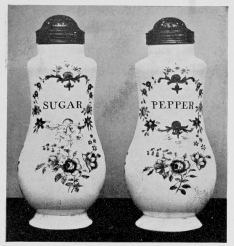
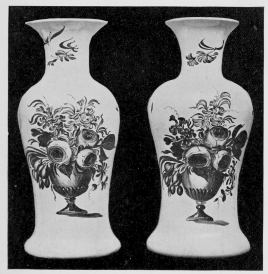
FIG. 27.—SPECIMENS OF OPAQUE WHITE BRISTOL GLASS. 18th CENTURY.
(Decorated by M. Edkin.)
Edkin also decorated many blue ground pieces, and it is interesting to learn that his remuneration for the ornamentation of a jug51 in colour and gilt, which must have taken a considerable time, was the lordly sum of 8d., a striking commentary upon the value placed upon skilled craftsmanship52 in the eighteenth century. Like many other artists he had to be content with the posthumous53 reward which fame bestows54.
The Bristol factories are said to have made all sorts of articles, flasks55, bells, walking-sticks, bellows56, etc., in glass, but there is much uncertainty57 on this head, and I doubt if the greater part of such articles classified as coming from Bristol should not, as a matter of fact, claim Nailsea as their place of origin. We can certainly ascribe oil, vinegar, and pepper pots, candlesticks, salt-cellars, and vases to Bristol, as the daintily decorated pepper and sugar castors, shown in Fig. 27, prove, so that it is at least possible for the other articles enumerated58 also to have been made there, but where there is so much uncertainty, the collector who desires to be on the safe side had better refrain from giving Bristol the benefit of the doubt.
It must not be inferred, however, that all{126} Bristol glass is of the opaque kind. The magnificent piece shown in the frontispiece is quite transparent, the apparent opacity59 of the background of the landscape being due to enamel laid on the glass. The fine decanter reproduced in Fig. 25 is also an example of what Bristol could do in transparent glass, the decoration, here again, being in enamel.
Nailsea Glass.—The glass-works of Nailsea were established in 1788, a few miles to the south-west of Bristol, and were, for some time, carried on with success; but the ware was crude and lacking in the finish characteristic of the best Bristol specimens. The earliest pieces were made of yellowish or dark green glass, with blotches60 of white, as in the jug shown in Fig. 28. They were usually very inferior in style, colour, texture, and workmanship, and were consequently not greatly sought after by purchasers; hence the output was restricted, and the factory after a while seems to have confined its efforts to producing plain white glass with quaint61 and curious forms of decoration. A pair of bellows, for example, was decorated like the fins62 of a fish, with tiny projections63 and spines64 all over it. Towards the
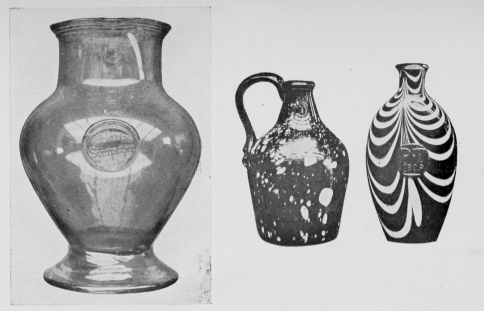
FIG. 28.—EARLY NAILSEA GLASS JUGS65. EARLY 19th CENTURY.
end of its career, which closed in 1763, the output was a clear glass of greenish tint66, with faintly coloured streaks. Fig. 29 is a characteristic example. I have also seen a few pieces gilt. The glass is now exceedingly scarce, and good specimens command a very high price. There is a curious charm about Nailsea glass. In appearance, the best specimens are of a dark toffee-like colour, and when held up to a strong light exhibit a greenish tinge67. The lighter68 and finer kinds display a characteristic ground which, if not beautiful, is certainly quaint. Collectors who are fortunate enough to come across a specimen of Nailsea at a reasonable figure should undoubtedly69 seize the opportunity of acquiring it, but such opportunities are few and, were they more numerous, it is hardly likely that anyone would wish to form a large collection of it. The “Simpson” Jug, illustrated70 in Fig. 28, is transparent, but of a curious yellowish-green tinge, and is probably one of the last pieces produced at the old factory.

点击 收听单词发音
收听单词发音
 收听单词发音
收听单词发音
1
previously

|
|
| adv.以前,先前(地) | |
参考例句: |
|
|
|
2
undertaking

|
|
| n.保证,许诺,事业 | |
参考例句: |
|
|
|
3
apprentice

|
|
| n.学徒,徒弟 | |
参考例句: |
|
|
|
4
premium

|
|
| n.加付款;赠品;adj.高级的;售价高的 | |
参考例句: |
|
|
|
5
entirely

|
|
| ad.全部地,完整地;完全地,彻底地 | |
参考例句: |
|
|
|
6
specimens

|
|
| n.样品( specimen的名词复数 );范例;(化验的)抽样;某种类型的人 | |
参考例句: |
|
|
|
7
specimen

|
|
| n.样本,标本 | |
参考例句: |
|
|
|
8
blues

|
|
| n.抑郁,沮丧;布鲁斯音乐 | |
参考例句: |
|
|
|
9
opaque

|
|
| adj.不透光的;不反光的,不传导的;晦涩的 | |
参考例句: |
|
|
|
10
milky

|
|
| adj.牛奶的,多奶的;乳白色的 | |
参考例句: |
|
|
|
11
ware

|
|
| n.(常用复数)商品,货物 | |
参考例句: |
|
|
|
12
streaks

|
|
| n.(与周围有所不同的)条纹( streak的名词复数 );(通常指不好的)特征(倾向);(不断经历成功或失败的)一段时期v.快速移动( streak的第三人称单数 );使布满条纹 | |
参考例句: |
|
|
|
13
ornamented

|
|
| adj.花式字体的v.装饰,点缀,美化( ornament的过去式和过去分词 ) | |
参考例句: |
|
|
|
14
fig

|
|
| n.无花果(树) | |
参考例句: |
|
|
|
15
renowned

|
|
| adj.著名的,有名望的,声誉鹊起的 | |
参考例句: |
|
|
|
16
bequest

|
|
| n.遗赠;遗产,遗物 | |
参考例句: |
|
|
|
17
commemorate

|
|
| vt.纪念,庆祝 | |
参考例句: |
|
|
|
18
expenditure

|
|
| n.(时间、劳力、金钱等)支出;使用,消耗 | |
参考例句: |
|
|
|
19
costly

|
|
| adj.昂贵的,价值高的,豪华的 | |
参考例句: |
|
|
|
20
gaol

|
|
| n.(jail)监狱;(不加冠词)监禁;vt.使…坐牢 | |
参考例句: |
|
|
|
21
brittle

|
|
| adj.易碎的;脆弱的;冷淡的;(声音)尖利的 | |
参考例句: |
|
|
|
22
enamel

|
|
| n.珐琅,搪瓷,瓷釉;(牙齿的)珐琅质 | |
参考例句: |
|
|
|
23
porcelain

|
|
| n.瓷;adj.瓷的,瓷制的 | |
参考例句: |
|
|
|
24
utensils

|
|
| 器具,用具,器皿( utensil的名词复数 ); 器物 | |
参考例句: |
|
|
|
25
earthenware

|
|
| n.土器,陶器 | |
参考例句: |
|
|
|
26
transparent

|
|
| adj.明显的,无疑的;透明的 | |
参考例句: |
|
|
|
27
enthusiast

|
|
| n.热心人,热衷者 | |
参考例句: |
|
|
|
28
texture

|
|
| n.(织物)质地;(材料)构造;结构;肌理 | |
参考例句: |
|
|
|
29
hue

|
|
| n.色度;色调;样子 | |
参考例句: |
|
|
|
30
peculiar

|
|
| adj.古怪的,异常的;特殊的,特有的 | |
参考例句: |
|
|
|
31
craftsmen

|
|
| n. 技工 | |
参考例句: |
|
|
|
32
scrutiny

|
|
| n.详细检查,仔细观察 | |
参考例句: |
|
|
|
33
drawn

|
|
| v.拖,拉,拔出;adj.憔悴的,紧张的 | |
参考例句: |
|
|
|
34
perfectly

|
|
| adv.完美地,无可非议地,彻底地 | |
参考例句: |
|
|
|
35
overdone

|
|
| v.做得过分( overdo的过去分词 );太夸张;把…煮得太久;(工作等)过度 | |
参考例句: |
|
|
|
36
inevitably

|
|
| adv.不可避免地;必然发生地 | |
参考例句: |
|
|
|
37
abruptly

|
|
| adv.突然地,出其不意地 | |
参考例句: |
|
|
|
38
authenticity

|
|
| n.真实性 | |
参考例句: |
|
|
|
39
flask

|
|
| n.瓶,火药筒,砂箱 | |
参考例句: |
|
|
|
40
pitfalls

|
|
| (捕猎野兽用的)陷阱( pitfall的名词复数 ); 意想不到的困难,易犯的错误 | |
参考例句: |
|
|
|
41
dealer

|
|
| n.商人,贩子 | |
参考例句: |
|
|
|
42
exquisite

|
|
| adj.精美的;敏锐的;剧烈的,感觉强烈的 | |
参考例句: |
|
|
|
43
enamels

|
|
| 搪瓷( enamel的名词复数 ); 珐琅; 釉药; 瓷漆 | |
参考例句: |
|
|
|
44
enameller

|
|
| 搪瓷工人 | |
参考例句: |
|
|
|
|
45
painstaking

|
|
| adj.苦干的;艰苦的,费力的,刻苦的 | |
参考例句: |
|
|
|
46
artistic

|
|
| adj.艺术(家)的,美术(家)的;善于艺术创作的 | |
参考例句: |
|
|
|
47
delicacy

|
|
| n.精致,细微,微妙,精良;美味,佳肴 | |
参考例句: |
|
|
|
48
continental

|
|
| adj.大陆的,大陆性的,欧洲大陆的 | |
参考例句: |
|
|
|
49
gilt

|
|
| adj.镀金的;n.金边证券 | |
参考例句: |
|
|
|
50
affected

|
|
| adj.不自然的,假装的 | |
参考例句: |
|
|
|
51
jug

|
|
| n.(有柄,小口,可盛水等的)大壶,罐,盂 | |
参考例句: |
|
|
|
52
craftsmanship

|
|
| n.手艺 | |
参考例句: |
|
|
|
53
posthumous

|
|
| adj.遗腹的;父亡后出生的;死后的,身后的 | |
参考例句: |
|
|
|
54
bestows

|
|
| 赠给,授予( bestow的第三人称单数 ) | |
参考例句: |
|
|
|
55
flasks

|
|
| n.瓶,长颈瓶, 烧瓶( flask的名词复数 ) | |
参考例句: |
|
|
|
56
bellows

|
|
| n.风箱;发出吼叫声,咆哮(尤指因痛苦)( bellow的名词复数 );(愤怒地)说出(某事),大叫v.发出吼叫声,咆哮(尤指因痛苦)( bellow的第三人称单数 );(愤怒地)说出(某事),大叫 | |
参考例句: |
|
|
|
57
uncertainty

|
|
| n.易变,靠不住,不确知,不确定的事物 | |
参考例句: |
|
|
|
58
enumerated

|
|
| v.列举,枚举,数( enumerate的过去式和过去分词 ) | |
参考例句: |
|
|
|
59
opacity

|
|
| n.不透明;难懂 | |
参考例句: |
|
|
|
60
blotches

|
|
| n.(皮肤上的)红斑,疹块( blotch的名词复数 );大滴 [大片](墨水或颜色的)污渍 | |
参考例句: |
|
|
|
61
quaint

|
|
| adj.古雅的,离奇有趣的,奇怪的 | |
参考例句: |
|
|
|
62
fins

|
|
| [医]散热片;鱼鳍;飞边;鸭掌 | |
参考例句: |
|
|
|
63
projections

|
|
| 预测( projection的名词复数 ); 投影; 投掷; 突起物 | |
参考例句: |
|
|
|
64
spines

|
|
| n.脊柱( spine的名词复数 );脊椎;(动植物的)刺;书脊 | |
参考例句: |
|
|
|
65
jugs

|
|
| (有柄及小口的)水壶( jug的名词复数 ) | |
参考例句: |
|
|
|
66
tint

|
|
| n.淡色,浅色;染发剂;vt.着以淡淡的颜色 | |
参考例句: |
|
|
|
67
tinge

|
|
| vt.(较淡)着色于,染色;使带有…气息;n.淡淡色彩,些微的气息 | |
参考例句: |
|
|
|
68
lighter

|
|
| n.打火机,点火器;驳船;v.用驳船运送;light的比较级 | |
参考例句: |
|
|
|
69
undoubtedly

|
|
| adv.确实地,无疑地 | |
参考例句: |
|
|
|
70
illustrated

|
|
| adj. 有插图的,列举的 动词illustrate的过去式和过去分词 | |
参考例句: |
|
|
|
| 欢迎访问英文小说网 |

